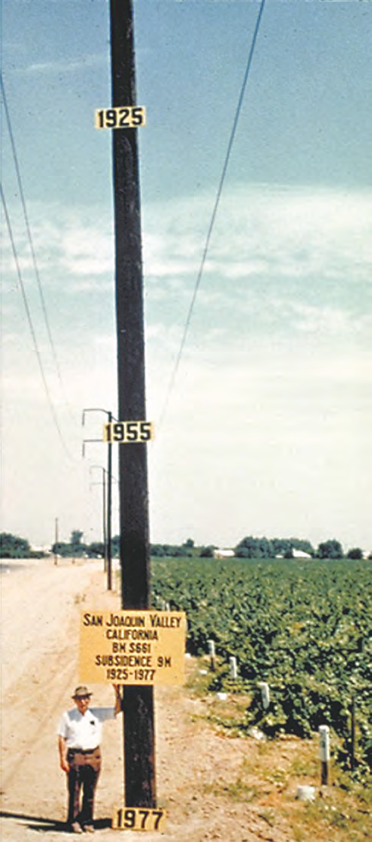
New EPRI Center to Spur Collaboration on Vital Groundwater Issues
The ground is sinking beneath our feet. That’s not the beginning of a science fiction novel. In certain locations, it is a literal fact. Take a look at a photo (right) from California’s San Joaquin Valley. It’s startling to see that the ground level has dropped by as much as 35 feet since the 1920s. This phenomenon, known as subsidence, is due largely to groundwater being withdrawn faster than it can be replenished by rainfall.
Groundwater—the water that fills underground spaces in soil, rock, and sand—is critically important to society, including the power industry. Currently, 82 billion gallons of groundwater are used each day in the United States. It supplies drinking water to more than half of the population. Based on data from the U.S. Geological Survey, the great majority of groundwater withdrawals are for agricultural irrigation.
While the power industry relies primarily on surface water to cool power plants and for other purposes, it still uses about two billion gallons of groundwater daily. Another important consideration for the industry is the link between groundwater and surface water. “Groundwater is a major contributor to surface water,” said EPRI Technical Executive Ken Ladwig. “They are tied together.”
Research Clearinghouse and Platform for Collaboration
EPRI recently launched its virtual Groundwater Center to serve as an information hub and a platform for electricity sector collaboration on this complex issue. The center reflects the industry’s priorities of monitoring and managing this limited resource.
An important component of the center is a website to serve as a clearinghouse for groundwater-related EPRI research reports as well as studies, news, and best practices produced by diverse stakeholders with groundwater expertise. “We are going to have links, news items, and summaries of external research at the U.S. Geological Survey, U.S. Environmental Protection Agency, and several university consortiums devoted to groundwater,” said Ladwig, who manages the center. “The purpose is to bring together both these external resources and EPRI resources to provide comprehensive, quick access to key information needed to anticipate risks and establish action plans.”
The center is also expected to be a springboard for expanded research collaboration across EPRI. Potential research areas include groundwater–surface water interactions, applications of models and other advanced assessment tools, and tests on groundwater supply and remediation technologies. By raising awareness of groundwater research among different arms of EPRI and other organizations, the center can help avoid duplication of efforts for better management of funders’ resources. “There are plenty of opportunities for synergy across different EPRI research programs and for facilitating interaction with other groups,” said Ladwig.
Conferences and Workshops
The Groundwater Center will organize an annual conference for member companies, academics, government researchers, and other technical experts to share research and case study results. It will host workshops to provide utility field project managers and others with practical knowledge about site assessments, data interpretation, and analytical methods, helping them better manage groundwater. The first workshop, tentatively scheduled for fall 2015, will likely focus on groundwater modeling.
Better serving society’s long-term interests is a unifying theme among the Groundwater Center’s projects and topics. “While the center will help power companies directly address near-term needs related to groundwater, its activities are also driven by EPRI’s public interest mission,” said Ladwig. “Effectively managing groundwater today is critical to ensuring a healthy resource in the future.”
EPRI Technical Expert:
Ken Ladwig


